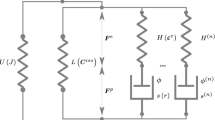Abstract
Constitutive properties for highly cross-linked glassy polymers are currently determined by molecular dynamics (MD) simulations. This avoids the need for ad-hoc experimentation. Constitutive data in functional form, such as yield surfaces, still require identification and correspondence to an existing function. In addition, loss of information occurs with fitting procedures. The present alternative consists in directly defining piecewise-linear yield functions from a set of points obtained by MD simulations. To prevent the algorithmic issues of multisurface plasticity, we propose an alternative to active-set strategies by simultaneously including all yield functions regardless of being active. We smooth the complementarity conditions using the Chen–Mangasarian function. In addition, extrapolation is proposed for slowly-evolving quantities such as the effective plastic strain while fully implicit integration is adopted for rapidly-evolving constitutive quantities. Since polymers exhibit finite-strain behavior, we propose a semi-implicit integration algorithm which allows a small number of steps to be used up to very large strains. Experimentally-observed effects herein considered are: thermal effects on strain (i.e. thermal expansion), Young’s modulus dependence on temperature and the effects of strain rate and temperature on the yield stress. A prototype model is first studied to assess the performance of the integration algorithm, followed by a experimental validation and a fully-featured, thermally-coupled 2D example.








Similar content being viewed by others
Notes
We use standard notation in continuum mechanics (Truesdell and Noll 2004).
Both elastic and inelastic terms contribute to \(\Delta \check{\varvec{S}}_{ab}.\)
References
Areias, P., Belytschko, T.: Analysis of finite strain anisotropic elastoplastic fracture in thin plates and shells. J. Aerosp. Eng. 19(4), 259–270 (2006)
Areias, P., Rabczuk, T.: Smooth finite strain plasticity with non-local pressure support. Int.J. Numer. Methods Eng. 81, 106–134 (2010)
Areias, P., Dias-da-Costa, D., Pires, E.B., Infante Barbosa, J.: A new semi-implicit formulation for multiple-surface flow rules in multiplicative plasticity. Comput. Mech. 49, 545–564 (2012)
Areias, P., Dias-da Costa, D., Sargado, J.M., Rabczuk, T.: Element-wise algorithm for modeling ductile fracture with the Rousselier yield function. Comput. Mech. 52, 1429–1443 (2013)
Areias, P., Rabczuk, T., de Sá, JCésar: Semi-implicit finite strain constitutive integration of porous plasticity models. Finite Elem. Anal. Des. 104, 41–55 (2015a)
Areias, P., Rabczuk, T., de Sá, JMCésar, Garção, J.E.: Finite strain quadrilateral shell using least-squares fit of relative lagrangian in-plane strains. Finite Elem. Anal. Des. 98, 26–40 (2015b)
Argon, A.S.: A theory for the low-temperature plastic deformation of glassy polymers. Philos. Mag. 28(4), 839–865 (1973)
Bouvard, J.L., Ward, D.K., Hossain, D., Nouranian, S., Marin, E.B., Horstemeyer, M.F.: Review of hierarchical multiscale modeling to describe the mechanical behavior of amorphous polymers. J. Eng. Mater. Technol. 131(4), 041206 (2009)
Chen, C., Mangasarian, O.L.: Smoothing methods for convex inequalities and linear complementarity problems. Math. Program 71(1), 51–69 (1995)
Cook, W.D., Mayr, A.E., Edward, G.H.: Yielding behaviour in model epoxy thermosets-II. Temperature dependence. Polymer 39(16), 3725–3733 (1998)
Holzapfel, G.A.: Nonlinear Solid Mechanics: A Continuum Approach for Engineers. Wiley, Hoboken (2000)
Hughes, T.J.R.: The Finite Element Method. Dover Publications, Mineola (2000) (Reprint of Prentice-Hall edition (1987))
Johnson, G.R., Cook. W.H.: A constitutive model and data for metals subjected to large strains, high strain rates and high temperatures. In: Proceedings of the 7th International Symposium on Ballistics, pp. 541–547 (1983)
Korelc, J.: Multi-language and multi-environment generation of nonlinear finite element codes. Eng. Comput. 18(4), 312–327 (2002)
Lee, E.H.: Elasto-plastic deformation at finite strains. J. Appl. Mech. ASME 36, 1–6 (1969)
Mayr, A.E., Cook, W.D., Edward, G.H.: Yielding behaviour in model epoxy thermosets-I. Effect of strain rate and composition. Polymer 39(16), 3719–3724 (1998)
Plimpton, Steve: Fast parallel algorithms for short-range molecular dynamics. J. Comput. Phys. 117(1), 1–19 (1995)
Poulain, X., Benzerga, A.A., Goldberg, R.K.: Finite-strain elasto-viscoplastic behavior of an epoxy resin: experiments and modeling in the glassy regime. Int. J. Plast. 62, 138–161 (2014)
Wolfram Research Inc. Mathematica (2007)
Simo, J.C., Hughes, T.J.R.: Computational Inelasticity. Springer, Berlin, Corrected Second Printing edition (2000)
Stachurski, Z.H.: Deformation mechanisms and yield strength in amorphous polymers. Prog. Polym. Sci. 22, 407–474 (1997)
Sundaraghavan, V., Kumar, A.: Molecular dynamics simulations of compressive yielding in cross-linked epoxies in the context of argon theory. Int. J. Plast. 47, 111–125 (2013)
Taylor, G.I., Quinney, H.: The latent energy remaining in metal after cold working. Proc. R. Soc. A413, 307–326 (1934)
Truesdell, C., Noll, W.: The Non-linear Field Theories of Mechanics, 3rd edn. Springer, Berlin (2004)
Vu-Bac, N., Bessa, M.A., Rabczuk, Timon, Liu, Wing Kam: A multiscale model for the quasi-static thermo-plastic behavior of highly cross-linked glassy polymers. Macromolecules 48(18), 6713–6723 (2015)
Vu-Bac, N., Areias, P., Rabczuk, T.: A multiscale multisurface constitutive model for the thermo-plastic behavior of polyethylene. Polymer 105, 327–338 (2016)
Wernik, J.M., Meguid, S.A.: Coupling atomistics and continuum in solids: status, prospects, and challenges. Int. J. Mech. Mater. Des. 5, 79–110 (2009)
Author information
Authors and Affiliations
Corresponding author
Appendix
Appendix
Concerning the result (12), and ignoring the body force term for conciseness, we have the integration by parts formula:
since \(\varvec{e}_{ab}=\frac{1}{2}\left( \varvec{F}_{ab}^{T}\varvec{F}_{ab}-\varvec{I}\right)\) and \(\dot{\varvec{e}}_{ab}=\frac{1}{2}\left( \dot{\varvec{F}}_{ab}^{T}\varvec{F}_{ab}+\varvec{F}_{ab}^{T}\varvec{F}_{ab}\right)\) but \(\dot{\varvec{F}}_{ab}{={\nabla }}_{b}\dot{\varvec{u}}_{a}\) we have
However, symmetry of \(\varvec{S}_{ab}\) results in: \(\left[ \varvec{S}_{ab}\right] _{ij}\left[ \dot{\varvec{F}}_{ab}\right] _{ik}\left[ \varvec{F}_{ab}\right] _{kj}=\left[ \varvec{S}_{ab}\right] _{ij}\left[ \dot{\varvec{F}}_{ab}\right] _{jk}\left[ \varvec{F}_{ab}\right] _{ki}\) which implies that
Finally, by using Voigt notation for \(\varvec{S}_{ab}\) and \(\dot{\varvec{e}}_{ab}\),
Rights and permissions
About this article
Cite this article
Areias, P., Vu-Bac, N. & Rabczuk, T. A multisurface constitutive model for highly cross-linked polymers with yield data obtained from molecular dynamics simulations. Int J Mech Mater Des 14, 21–36 (2018). https://doi.org/10.1007/s10999-016-9358-x
Received:
Accepted:
Published:
Issue Date:
DOI: https://doi.org/10.1007/s10999-016-9358-x



